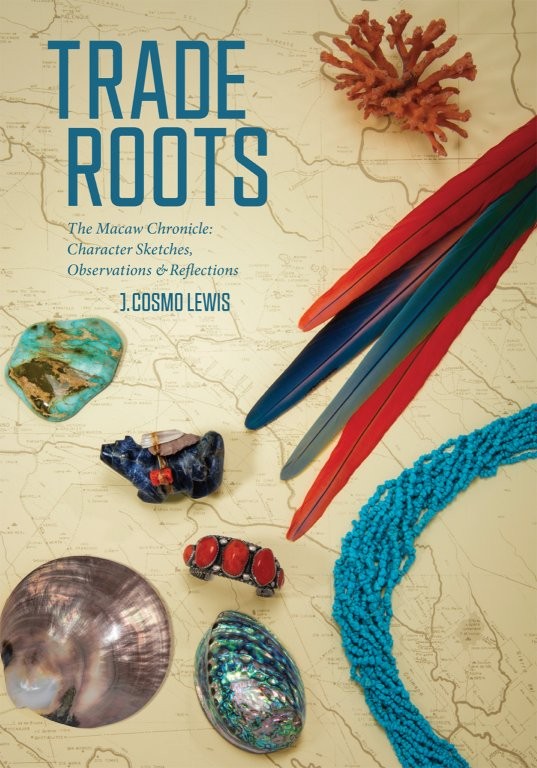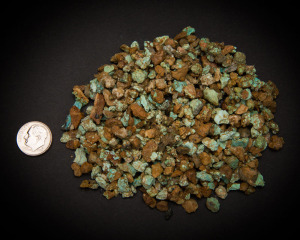Number 8 Turquoise Mine
Located in the Lynn mining district (no. 19, pl. 1 ) in northern Eureka County, north of Carlin, Nevada, the Number 8 turquoise mine is on the west side of the Tuscarora Range in the NW 1/4 sec. 4, T. 35 N., R. 50 E., and was at one time a gold and copper mining operation. It was in a large mining district encompassing ten 20-acre claims and was active from the 1930’s through the early 1950’s. Host rocks for the Number 8 deposit consist of intensely altered quartz monzonite, shale, and thinly bedded black chert, which are complexly folded, faulted, and much altered. Turquoise is concentrated along quartz veins in the intrusive rock and along faults in the sedimentary rocks.
History of the Number 8 Turquoise Mine
The number 8 mine was presumably discovered about 1925 by a barber from Carlin whose name has been forgotten, because he made no attempt to mine the property. The mine was rediscovered by Earl Buffington and Lawrence Springer in 1929. They filed formal claim to the property and proceeded to mine turquoise in serious fashion, producing about 1,800 pounds of good stone the first year. In 1930 Ted Johnson bought Buffington's interest and during the next four years produced about 5,000 pounds of commercial stone. In 1935 Doc Wilson bought the number 8 mine from Johnson but did nothing with the property and the claim lapsed. Myron Clark relocated the claim and, after working it for awhile, sold it to Lee Hand. Hand operated the mine for a short time, but became dissatisfied with the quality of the stone, and sold it to the five Edgar brothers who now own it. The Edgars extended operations and produced a considerable amount of fair-to-good turquoise.
In 1950, as most of the visible turquoise had been taken from the workings, the Edgars hired a contractor with bulldozer equipment to remove overburden from another part of the claim. A deposit of copper had been found on the property, and the Edgars thought they might mine copper if they did not find more turquoise. The bulldozer, after digging a pit about eight feet deep and 80 feet long, uncovered a deposit of some of the finest spider-web turquoise ever found in Nevada. The deposit was mostly in nodules, some of gigantic size.
Number 8 Turquoise
One of the largest pieces of turquoise and matrix in the modern world, perhaps the largest nodule ever uncovered, was discovered at the Number 8 mine on June 23, 1954, by T. G. Edgar, J. M. Edgar, and Marvin Symes. This specimen was 33 inches long, 18.5 inches wide, and seven inches thick. Cleaned and polished it weighed 150 pounds. The nodule was of excellent texture, good color and hardness, and ranked with any turquoise of good commercial grade. Another nodule, of excellent quality, weighed more than nine pounds. It was sold to C. G. Wallace, of Zuni, New Mexico, for $1,600. The discovery proved to be a rather large-pocket and produced more than 1,600 pounds of the very highest grade turquoise before being worked out. Spurred by this find, the Edgars further explored the property, without finding any more spider-web turquoise of notable quantity. Other turquoise was discovered, however, of good commercial grade, sufficient to keep the mine in operation.
Of the ten claims in this 20-acre area, the Number 8, first claimed by the Blue Star Company in Lander County, is considered the finest example of the gold-webbed turquoise. The mine has produced one of the most prized spider web turquoise deposits in the world. In its prime, enormous nodules were found, including one that weighed 150 pounds. Number 8 turquoise is famous for its black, golden-red and brown spider web matrix background, which is set off by the soft blue to blue green turquoise. Only rarely does gem material appear: a very dark blue turquoise with black spider web matrix. The mine is now depleted and Number 8 turquoise is extremely rare and valuable.
History of the Number 8 Turquoise Mine
The number 8 mine was presumably discovered about 1925 by a barber from Carlin whose name has been forgotten, because he made no attempt to mine the property. The mine was rediscovered by Earl Buffington and Lawrence Springer in 1929. They filed formal claim to the property and proceeded to mine turquoise in serious fashion, producing about 1,800 pounds of good stone the first year. In 1930 Ted Johnson bought Buffington's interest and during the next four years produced about 5,000 pounds of commercial stone. In 1935 Doc Wilson bought the number 8 mine from Johnson but did nothing with the property and the claim lapsed. Myron Clark relocated the claim and, after working it for awhile, sold it to Lee Hand. Hand operated the mine for a short time, but became dissatisfied with the quality of the stone, and sold it to the five Edgar brothers who now own it. The Edgars extended operations and produced a considerable amount of fair-to-good turquoise.
In 1950, as most of the visible turquoise had been taken from the workings, the Edgars hired a contractor with bulldozer equipment to remove overburden from another part of the claim. A deposit of copper had been found on the property, and the Edgars thought they might mine copper if they did not find more turquoise. The bulldozer, after digging a pit about eight feet deep and 80 feet long, uncovered a deposit of some of the finest spider-web turquoise ever found in Nevada. The deposit was mostly in nodules, some of gigantic size.
Number 8 Turquoise
One of the largest pieces of turquoise and matrix in the modern world, perhaps the largest nodule ever uncovered, was discovered at the Number 8 mine on June 23, 1954, by T. G. Edgar, J. M. Edgar, and Marvin Symes. This specimen was 33 inches long, 18.5 inches wide, and seven inches thick. Cleaned and polished it weighed 150 pounds. The nodule was of excellent texture, good color and hardness, and ranked with any turquoise of good commercial grade. Another nodule, of excellent quality, weighed more than nine pounds. It was sold to C. G. Wallace, of Zuni, New Mexico, for $1,600. The discovery proved to be a rather large-pocket and produced more than 1,600 pounds of the very highest grade turquoise before being worked out. Spurred by this find, the Edgars further explored the property, without finding any more spider-web turquoise of notable quantity. Other turquoise was discovered, however, of good commercial grade, sufficient to keep the mine in operation.
Of the ten claims in this 20-acre area, the Number 8, first claimed by the Blue Star Company in Lander County, is considered the finest example of the gold-webbed turquoise. The mine has produced one of the most prized spider web turquoise deposits in the world. In its prime, enormous nodules were found, including one that weighed 150 pounds. Number 8 turquoise is famous for its black, golden-red and brown spider web matrix background, which is set off by the soft blue to blue green turquoise. Only rarely does gem material appear: a very dark blue turquoise with black spider web matrix. The mine is now depleted and Number 8 turquoise is extremely rare and valuable.
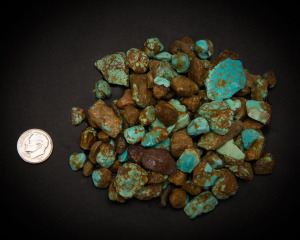
Number 8 Mine IV, Stabilized
Although lightly hardened, this are very nice nuggets for cabbing. Color is a blue-green with that classic brown webbing
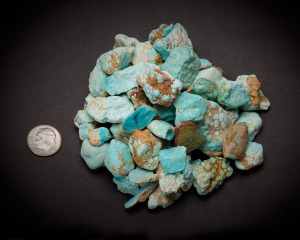
Number 8 Turquoise - I Mixed Blues
Classic Blue Number 8 Mine; some clear and some with gold matrix. Good for cabochons or inlay.
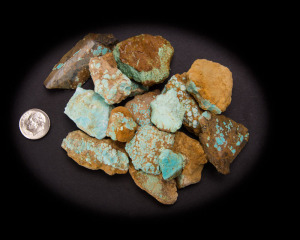
Number 8 Turquoise III, Mine Run
This a mix of classic Number 8 mine turquoise. There are blues, greens and blue-greens. Sometimes clear,but usually with a gold matrix. Ideal for cabochons.
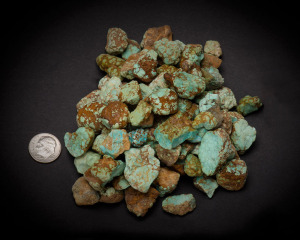
Number 8 Turquoise-II Mixed Blue Greens with Brown Spiderweb
The color tends from blue to blue-green. The Brown Spider webbing makes this perfect for Cabs.
Back
Ajax Turquoise
Arizona Blue Turquoise
Bisbee Turquoise
Blue Diamond Turquoise
Blue Gem Turquoise
Carico Lake Turquoise
Crescent Valley Turquoise
Cripple Creek Turquoise
Damale Turquoise
Evans Turquoise
Fox Turquoise
Gold Canyon Turquoise
Cloud Mountain Turquoise
Kingman Turquoise
Maanshan Turquoise
Morenci Turquoise
Northern Lights Turquoise
Number Eight Turquoise
Pilot Mountain Turquoise
Royston Turquoise
Sleeping Beauty Turquoise
Other Turquoise & Variscite Mines
View Shopping Cart
